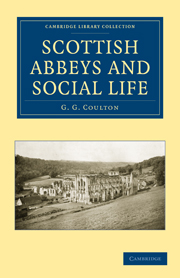Book contents
- Frontmatter
- Contents
- LIST OF ILLUSTRATIONS
- Preface
- Chapter I Celtic Monachism
- Chapter II The Monastic Rules
- Chapter III Monastic Revenues
- Chapter IV How Endowments Came (I)
- Chapter V How Endowments Came (II)
- Chapter VI Monks and Parishes (I)
- Chapter VII Monks and Parishes (II)
- Chapter VIII Charity (I)
- Chapter IX Charity (II)
- Chapter X Monk and Peasant (I)
- Chapter XI Monk and Peasant (II)
- Chapter XII Monastic Housekeeping
- Chapter XIII Church and Scriptorium
- Chapter XIV The Monastic Chronicler
- Chapter XV Schools
- Chapter XVI Art and Learning
- Chapter XVII Professions and Business
- Chapter XVIII Visitation (I)
- Chapter XIX Visitation (II)
- Chapter XX A Voice from the Cloister
- Chapter XXI Conclusion
- Appendixes
- List of Authorities
- Index
Chapter III - Monastic Revenues
Published online by Cambridge University Press: 05 August 2011
- Frontmatter
- Contents
- LIST OF ILLUSTRATIONS
- Preface
- Chapter I Celtic Monachism
- Chapter II The Monastic Rules
- Chapter III Monastic Revenues
- Chapter IV How Endowments Came (I)
- Chapter V How Endowments Came (II)
- Chapter VI Monks and Parishes (I)
- Chapter VII Monks and Parishes (II)
- Chapter VIII Charity (I)
- Chapter IX Charity (II)
- Chapter X Monk and Peasant (I)
- Chapter XI Monk and Peasant (II)
- Chapter XII Monastic Housekeeping
- Chapter XIII Church and Scriptorium
- Chapter XIV The Monastic Chronicler
- Chapter XV Schools
- Chapter XVI Art and Learning
- Chapter XVII Professions and Business
- Chapter XVIII Visitation (I)
- Chapter XIX Visitation (II)
- Chapter XX A Voice from the Cloister
- Chapter XXI Conclusion
- Appendixes
- List of Authorities
- Index
Summary
In this and the next two chapters, I propose to sketch briefly how the monks got their revenues, and how they spent them. Taking the whole of Europe together, the monastic income has sometimes been reckoned as one-third of the total; and at certain times and places it may perhaps have amounted to something approaching this. In Scotland it was greater than the average, and so I think it was in Switzerland, another mountainous country where, as I hope to show later on, there were close analogies with Scottish conditions. In both cases, a comparatively undeveloped country was brought into contact with more numerous and richer and more highly developed neigh-bours; and, naturally, it was the most complex and powerful institution among this majority which most impressed itself upon the minority. Since, therefore, in those days monasticism had this compactness and impressive force beyond any other social organization, naturally that proved the main factor in the Southern influence over Scotland. In Celtic times, there had been no parochial system; it may almost be said that the only church then was the monastic church; and the newer monasticism inherited a great deal of this earlier superiority.
We have seen how, within a single century from 1136 to 1229, eleven houses were founded in Scotland from what we may roughly call the newest and most efficient Order, the Cistercians. Fresh blood was transfused into Northern veins from the healthiest body that could be found; and I must dwell a little longer on this point.
- Type
- Chapter
- Information
- Scottish Abbeys and Social Life , pp. 38 - 52Publisher: Cambridge University PressPrint publication year: 2010First published in: 1933

